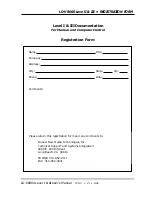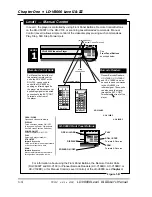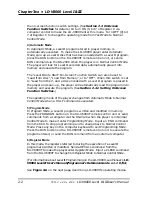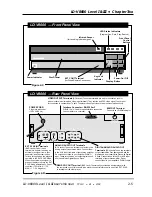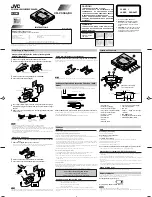
1 Introduction
Please refer first to the
Operating Instructions,
packaged with the LD-V8000, for
essential information about player operation and safety.
1.1 Scope
This manual is a reference guide to assist programmers and developers in using
the Pioneer Industrial Laser Videodisc Player, Model LD-V8000, marketed by
PioneerNew Media Technologies, Inc., Long Beach, California. It contains
information for basic Level I direct player control using the front panel buttons,
either of two remote control units (the RU-V6000T or the RU-V103), or a Pioneer
LaserBarcode Reader (UC-V104BC, UC-V108BC or the UC-V109BC). It also
contains technical information to assist programmers in the design and
development of Level III program applications to run under computer control.
The LD-V8000 is the most advanced videodisc player on the market today. It’s
video memory buffer enables a whole new range of “CLV interactive” capabilities.
The LD-V8000’s video memory buffer makes possible: CLV “freeze frame”, sound-
over-still, CLV multi-speed play; and “Frame Accurate” searches on CLV discs with
extended 24-bit code.
As of May 1992, players with EPROMs #DYW 1202 and #DYW 1194 and above offer
interleaved video playback to extend the length of playing time on a CAV or CLV disc.
Two new commands were added to the Level III command set to make interleaved
video playback possible. See Chapter 4 and Appendices G and H for details.
Other features that set the LD-V8000 player apart are: Four channels of audio
output, two analog and two digital; an internal composite sync generator for
syncing multiple players together; two video output signals for playback on two
monitors simultaneously; built-in LaserBarcode capability; and an EFM port, for
connection to the LD-ROM Adapter (DA-V1000).
All Pioneer Industrial Laser Videodisc Players (Models LD-V8000, LD-V4400, CLD-
V2400, LD-V2200, LD-V2000 and the discontinued LD-V4200, LD-V6000A and
LD-V6010A series) can be used as stand-alone systems. When connected to a
television or video monitor, they become self-contained interactive audio-video
retrieval and display systems for Level I use. They may also be connected to and
controlled by an external computer for Level III applications, often working in
conjunction with computer databases. How to control the LD-V8000 as part of a
Level I or Level III delivery system is the main focus of this Manual.
The LD-V8000 also has Level II capabilities: Programs can be created and loaded
into the player’s memory so that complex interactive instructional materials may
be presented, without requiring a computer at every workstation. Those planning
to develop Level II programs for the LD-V8000, should familiarize themselves with
LD-V8000 Level I & III • Chapter One
LD-V8000 Level I & III User’s Manual
TP 113
v. 2.1 • 2/93
1-1



